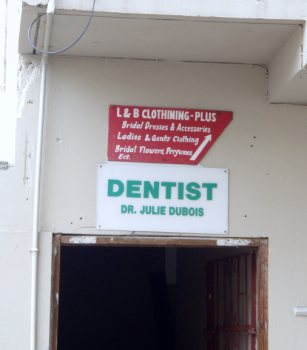A Bimble around St
George's
Each and every minibus that passes bibs you
to see if you want a lift. We hadn't reached the main gate of the marina before
one had stopped to see if we wanted to go into town for 50p. The "conductor"
stopped where we needed to get off and gave us directions to the museum. The
Grenada National Museum was opened in 1976 at the request of the Government. It
was funded by a group of citizens, who later formed the Grenada Historical
Society. There was a small display about slavery, a few stuffed birds and
mounted butterflies including a surprised looking armadillo. Would have liked to
insert picture, but photography forbidden in museum. Any I took I
sneaked.



Bear wandering around the sugar producing machinery. What were they doing with Josephine's bath?, and a military folding iron
bed.



A standard 112 pound
weight made in 1888. A photo I took from
outside looking in at the whaling and fishing
displays. The lovely metalwork on the canopy
outside.
There was a glass cabinet that contained a
typed letter from Buckingham Palace signed - Elizabeth - a thank you for the
lovely brooch the People of Grenada sent her as wedding present. A photo and
letter of the silver salver sent to Princess Margaret on her wedding day and a
lovely desk set sent for the opening of The Houses of Parliament.
The foundations of the museum are believed
to have been built by the French in 1704 as an army barracks, used by the
British as a Women's Common Goal from 1763 to 1880 or 1904 depending which book
you read. Then as a warehouse by local merchants, then the Gordon Hotel, Home
Hotel and later the Antilles Hotel. We left the museum to walk up to Fort
George.
Grenada has had boarding houses and rooms
to let since the 1700's to accommodate planters and businessmen visiting the
capital, as well as merchants and sailors. Many of the taverns and inns
populated the Granby Street or Market Square area and there is evidence that
they did brisk trade and the town took on a "boom town" feel with excellent
views of the sea. Many ships were prevented from sailing by tavern operators for
unpaid debts, as we see that today when signs are put up in Customs
and Immigration should a yacht not pay marina or boatyard
dues.
Granby Street named after John Manners,
Marquess of Granby, an accomplished and popular soldier, showed great concern
for his retired men giving them sufficient funds to establish taverns, most of
them named after him. Both Monckton
Hill Redoubt and Monckton Street were named after British General Robert
Monckton to whom Grenada fell without resistance in March 1762.
After the great fire of 1771, most of Granby Street debunked to
the town of Gouyave - now home of the famous "Fish Friday Oil-Down", a must
for on our next visit.
One of Grenada's first hotels was situated
on the intersection of Deponthieu Street, Market Hill and Grenville Street, was
owned and run by a Irish businesswoman Hannah Roe, as confirmed by French
records of 1779-1783. Cockroach was once a polite term for prostitute, hence
Deponthieu Street, once a notorious red-light area is still known by the locals
as Cockroach Alley.


A picture we took on entering St George's
we thought was a hotel. From the top of the hill en route to Fort George it
turned out to be the City Hospital now we see it from the back. Nice
view for the poorly.

Looking down from Fort George at the Government Buildings - the first one is the Finance
Department - along the Carenage. Directly opposite is the Fire Station painted
red. To the right the container ship dock.

Hurricane damaged building in the
foreground and the Catholic Cathedral behind,
currently having the roof repaired, it blew off during Hurricane
Ivan.



From the Fort this church looked really
cute with the frangipani in bloom beside it, sadly when we got a closer look we
found St Andrew's Presbyterian Kirk was quite
wrecked. Built in 1831 with the assistance of the Freemasons it is famous for
its bell cast in Glasgow in 1833 and its antique clock. Parked next to us was a
car with an Irish tourist sticker in the back window. The people of Grenada
really love the Brits and always smile and chat. We carried on down the hill and
wandered around the Mall which is really geared up for cruise ship visitors.
They can walk straight off the boat and into the mall without seeing daylight.
We found a Subway for lunch and then went to explore the fruit and veg market.
That was a real laugh, Ronda sorted us out a baby nutmeg grater,
her husband knocks them up. I was sold a piece of twig for 50p that I am to
boil and get Bear to drink the juice, "better than that Viagara, Sweetie,
give 'im some pep, let me know", I think for 50p I wont expect tooooooooooo
much.

The Grenada Dove (Leptotila
wellsi) is a medium-sized New World tropical dove. It is endemic to the island of Grenada and is the National Bird,
originally
known as the Pea Dove or Well's Dove. It is considered to be one of the most critically
endangered doves in the world (Bird Life International 2000) should have lived
in the aphrodisiac tree, but we never managed to see it. Something else on the
list to do when we come back.

En route to the bus station we passed
another first, a dentist sharing a building with a bridal
shop. I do hope the wiring is a bit more up to scratch
inside.

This beautiful
verandah was above the street corner opposite the bus station. A lively
and bustling place.
ALL IN ALL A FUN DAY
OUT.
















